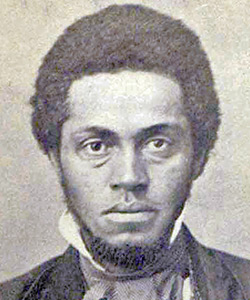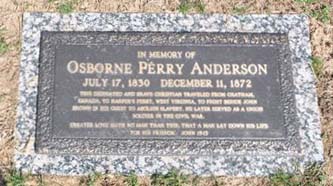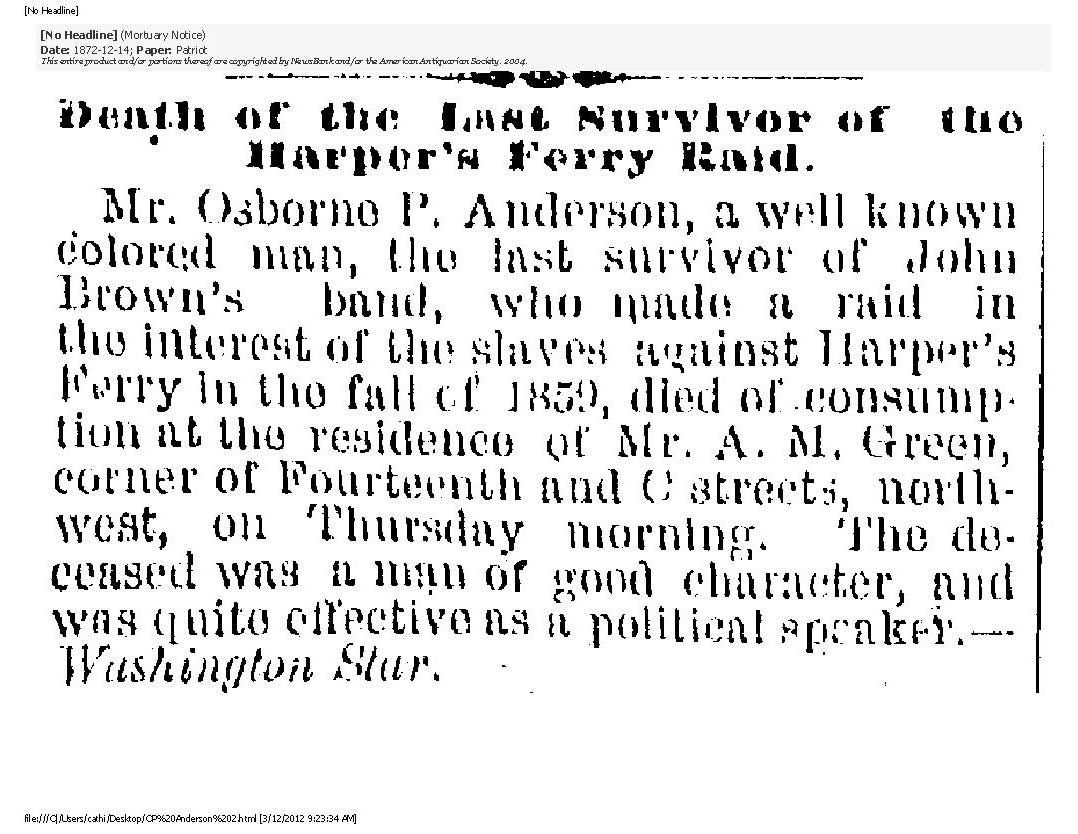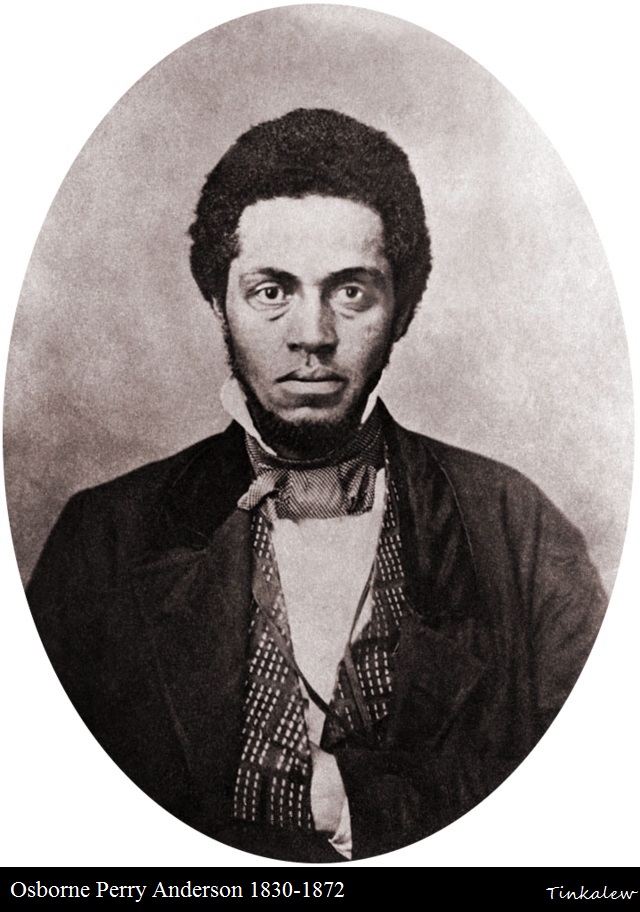Osborne Perry Anderson was born July 17, 1830, in West Fallowfield, Chester, Pennsylvania to free parents of African descent, Vincent Anderson and Sophia Taylor Anderson. His birth was followed by the birth of three brothers named James, John, and Emanuel.
Mr. Anderson was educated at Oberlin College; he was a printer by trade. Sometime after 1850, he left Pennsylvania for Canada. Some believe his venturing to Canada was directly linked to his association with Mary Ann Shadd Cary, who opened a school for African American children in West Chester, PA. Although Mrs. Shadd Cary’s influence may well have been critical in his decision to travel north, he may also have been influenced by Anderson family members already living in the area of Chatham, Ontario. Once in Chatham, Osborne worked for Shadd Cary as a printer of The Provincial Freeman newspaper.
In the spring of 1858, abolitionist John Brown arrived in Chatham for the purpose of holding the Chatham Convention. Osborn Perry Anderson was elected to Brown’s provisional government.2 Mr. Anderson went on to become one of only five men of African descent to accompany John Brown on his fateful raid on the United States arsenal at Harpers Ferry, Virginia (now West Virginia) in October 1859; he was the only one to survive.
In 1861, with the help of friend Mary Ann Shadd Cary, Osborne Anderson wrote "A Voice from Harper's Ferry." His opening sentence says that he wrote the "narrative [to] save from oblivion the facts connected with one of the most important movements of this age, with reference to the overthrow of American slavery.” “A Voice from Harper’s Ferry” stands as the only first-hand account of the Harpers Ferry events written by a member of John Brown’s army.3
Osborne Perry Anderson is reported to have served as a recruiter for the United States Colored Troops in Indiana and Arkansas in 1864, though some believe he may have served under a pseudonym as no documented account of his service has been found.4
Sometime during the 1860s, Mr. Anderson resided in Battle Creek, Michigan. On September 12-13, 1865 he was a delegate representing Battle Creek at the Colored Men’s Convention of the State of Michigan in Detroit.5
Osborne Perry Anderson’s sunset was on the morning of December 11, 1872, when he succumbed to consumption (tuberculosis). At the time of his death, Osborne was at the home of his friend, Mr. A. M. Green, who lived at 14th and C Streets, NW in Washington DC.
Mr. Anderson’s life was honored in a funeral service at the 15th Street Presbyterian Church in Washington. The service was conducted by Rev. Dr. Reeves, Bishop Green, and Rev. D. W. Anderson. His father, Vincent Anderson, was likely in attendance.
In December 1872 Osborne Perry Anderson was buried at Columbian Harmony Cemetery in Washington, DC. In 1959 several graves from Columbian Harmony Cemetery, including Mr. Anderson’s, were moved to National Harmony Cemetery in Prince George's County, Maryland. They now rest in the Columbian Harmony Society section of the cemetery.6
In November 2000, Osborne Perry Anderson and other prominent but oft-forgotten African American’s of the American Civil War era were honored in a ceremony at the cemetery. The ceremony was organized by the National Harmony Memorial Park, in conjunction with descendants of those buried in the Columbian Harmony Society Section. The plaque laid in honor of Osborne Perry Anderson reads,
“This dedicated and brave Christian traveled from Chatham, Canada to Harpers Ferry, W. Va. to fight beside John Brown in his quest to abolish slavery. He later served as a Union soldier in the Civil war.”
1 A Voice from Harper’s Ferry by Osborne P. Anderson, 1861. https://archive.org/details/voicefromharpers01ande
2 Delegates to John Brown’s Constitutional Convention of May 8, 1858, in Chatham, Canada…, an ongoing project by Jean Libby. http://www.africanafrican.com/folder12/african%20african%20american3/aboloitionists/Convention.pdf
3 BlackPast.org Remembered & Reclaimed, Anderson, Osborne P. (1930-1872) contributed by Ariana Westbrook http://www.blackpast.org/aah/anderson-osborne-p-1830-1872
4 Osborne Perry Anderson (1830-1872) by Jean Libby author of Black Voices From Harpers Ferry: Osborne Anderson and the John Brown Raid (1979)
5 Proceedings of the Colored Men’s Convention of the State of Michigan, Detroit, Tuesday and Wednesday, Sept 12-13, ’65, With Accompanying Documents. Also, The Constitution of the Equal Rights League of the State of Michigan. Colored Conventions. Bringing Nineteenth-Century Black Organizing to Digital Life.
6 At Cemetery, a John Brown Raider is Remembered by Eugene L. Meyer, The Washington Post, Washington D.C. Nov 16, 2000. Posted by Henrietta Vinton Davis, August 25, 2010. https://henriettavintondavis.wordpress.com/tag/osborne-perry-anderson/
The picture of Osborne Perry Anderson shown here is the only known image of him in existence. This photograph is in the Boyd B. Stutler Collection at the West Virginia State Archives. It is in the public domain.
THE FOUR ADDITIONAL BLACK RAIDERS:
Dangerfield NEWBY (Find A Grave Memorial ID 133482504) and
Lewis Sheridan LEARY (Find A Grave Memorial ID 123476133)
Mr. Newby and Mr. Leary were both killed during action at Harpers Ferry. They are buried at the John Brown Farm Grounds in North Elba, Essex County, New York.
Shields GREEN and John Anthony COPELAND, Jr.
Mr. Green and Mr. Copeland were captured and executed and their bodies were reportedly taken to the Winchester Medical College in Virginia for dissection by students in an anatomy laboratory.
Biography by: Catherine Meehan Blount
Osborne Perry Anderson was born July 17, 1830, in West Fallowfield, Chester, Pennsylvania to free parents of African descent, Vincent Anderson and Sophia Taylor Anderson. His birth was followed by the birth of three brothers named James, John, and Emanuel.
Mr. Anderson was educated at Oberlin College; he was a printer by trade. Sometime after 1850, he left Pennsylvania for Canada. Some believe his venturing to Canada was directly linked to his association with Mary Ann Shadd Cary, who opened a school for African American children in West Chester, PA. Although Mrs. Shadd Cary’s influence may well have been critical in his decision to travel north, he may also have been influenced by Anderson family members already living in the area of Chatham, Ontario. Once in Chatham, Osborne worked for Shadd Cary as a printer of The Provincial Freeman newspaper.
In the spring of 1858, abolitionist John Brown arrived in Chatham for the purpose of holding the Chatham Convention. Osborn Perry Anderson was elected to Brown’s provisional government.2 Mr. Anderson went on to become one of only five men of African descent to accompany John Brown on his fateful raid on the United States arsenal at Harpers Ferry, Virginia (now West Virginia) in October 1859; he was the only one to survive.
In 1861, with the help of friend Mary Ann Shadd Cary, Osborne Anderson wrote "A Voice from Harper's Ferry." His opening sentence says that he wrote the "narrative [to] save from oblivion the facts connected with one of the most important movements of this age, with reference to the overthrow of American slavery.” “A Voice from Harper’s Ferry” stands as the only first-hand account of the Harpers Ferry events written by a member of John Brown’s army.3
Osborne Perry Anderson is reported to have served as a recruiter for the United States Colored Troops in Indiana and Arkansas in 1864, though some believe he may have served under a pseudonym as no documented account of his service has been found.4
Sometime during the 1860s, Mr. Anderson resided in Battle Creek, Michigan. On September 12-13, 1865 he was a delegate representing Battle Creek at the Colored Men’s Convention of the State of Michigan in Detroit.5
Osborne Perry Anderson’s sunset was on the morning of December 11, 1872, when he succumbed to consumption (tuberculosis). At the time of his death, Osborne was at the home of his friend, Mr. A. M. Green, who lived at 14th and C Streets, NW in Washington DC.
Mr. Anderson’s life was honored in a funeral service at the 15th Street Presbyterian Church in Washington. The service was conducted by Rev. Dr. Reeves, Bishop Green, and Rev. D. W. Anderson. His father, Vincent Anderson, was likely in attendance.
In December 1872 Osborne Perry Anderson was buried at Columbian Harmony Cemetery in Washington, DC. In 1959 several graves from Columbian Harmony Cemetery, including Mr. Anderson’s, were moved to National Harmony Cemetery in Prince George's County, Maryland. They now rest in the Columbian Harmony Society section of the cemetery.6
In November 2000, Osborne Perry Anderson and other prominent but oft-forgotten African American’s of the American Civil War era were honored in a ceremony at the cemetery. The ceremony was organized by the National Harmony Memorial Park, in conjunction with descendants of those buried in the Columbian Harmony Society Section. The plaque laid in honor of Osborne Perry Anderson reads,
“This dedicated and brave Christian traveled from Chatham, Canada to Harpers Ferry, W. Va. to fight beside John Brown in his quest to abolish slavery. He later served as a Union soldier in the Civil war.”
1 A Voice from Harper’s Ferry by Osborne P. Anderson, 1861. https://archive.org/details/voicefromharpers01ande
2 Delegates to John Brown’s Constitutional Convention of May 8, 1858, in Chatham, Canada…, an ongoing project by Jean Libby. http://www.africanafrican.com/folder12/african%20african%20american3/aboloitionists/Convention.pdf
3 BlackPast.org Remembered & Reclaimed, Anderson, Osborne P. (1930-1872) contributed by Ariana Westbrook http://www.blackpast.org/aah/anderson-osborne-p-1830-1872
4 Osborne Perry Anderson (1830-1872) by Jean Libby author of Black Voices From Harpers Ferry: Osborne Anderson and the John Brown Raid (1979)
5 Proceedings of the Colored Men’s Convention of the State of Michigan, Detroit, Tuesday and Wednesday, Sept 12-13, ’65, With Accompanying Documents. Also, The Constitution of the Equal Rights League of the State of Michigan. Colored Conventions. Bringing Nineteenth-Century Black Organizing to Digital Life.
6 At Cemetery, a John Brown Raider is Remembered by Eugene L. Meyer, The Washington Post, Washington D.C. Nov 16, 2000. Posted by Henrietta Vinton Davis, August 25, 2010. https://henriettavintondavis.wordpress.com/tag/osborne-perry-anderson/
The picture of Osborne Perry Anderson shown here is the only known image of him in existence. This photograph is in the Boyd B. Stutler Collection at the West Virginia State Archives. It is in the public domain.
THE FOUR ADDITIONAL BLACK RAIDERS:
Dangerfield NEWBY (Find A Grave Memorial ID 133482504) and
Lewis Sheridan LEARY (Find A Grave Memorial ID 123476133)
Mr. Newby and Mr. Leary were both killed during action at Harpers Ferry. They are buried at the John Brown Farm Grounds in North Elba, Essex County, New York.
Shields GREEN and John Anthony COPELAND, Jr.
Mr. Green and Mr. Copeland were captured and executed and their bodies were reportedly taken to the Winchester Medical College in Virginia for dissection by students in an anatomy laboratory.
Biography by: Catherine Meehan Blount
Inscription
In Memory of
Osborne Perry Anderson
July 17, 1830 December 11, 1872
This dedicated and brave Christian traveled from Chatham, Canada, to Harper's Ferry, West Virginia, to fight beside John Brown in his quest to abolish slavery. He later served as a Union soldier in the Civil War.
"Greater love hath no man than this, that a man lay down his life for his friends."
John 15:13
Gravesite Details
Many of the graves moved from Columbian Harmony Cemetery to National Harmony Cemetery in 1959 were not adequately identified, therefore, the place where Mr. Anderson's plaque rests may not mark the spot of his actual resting place.






